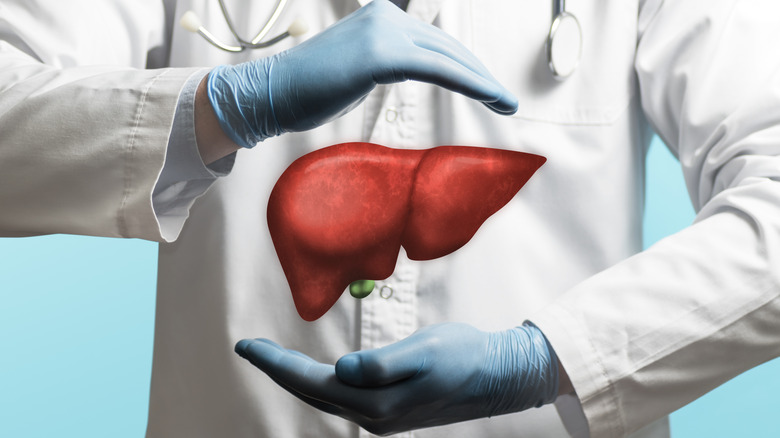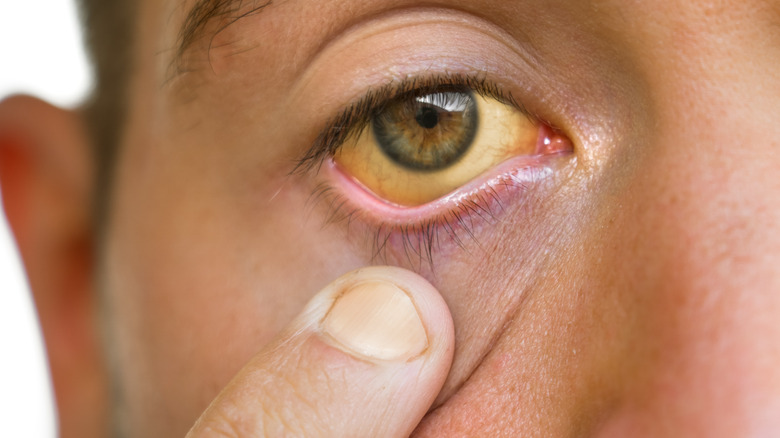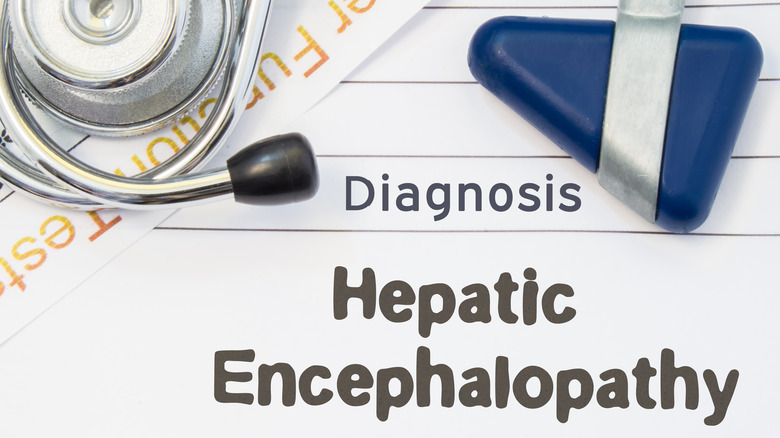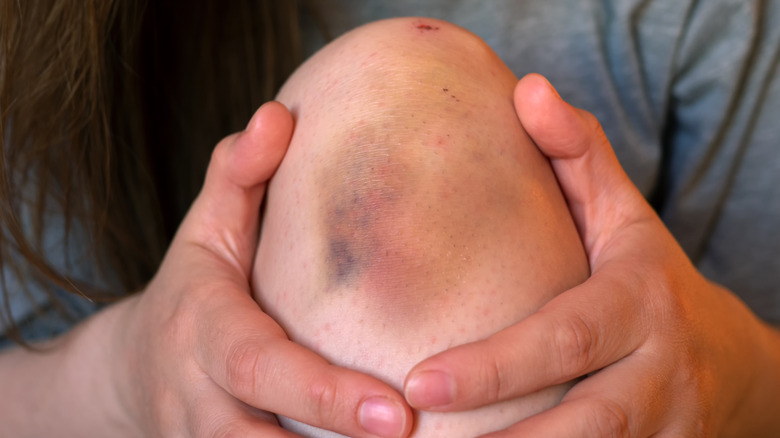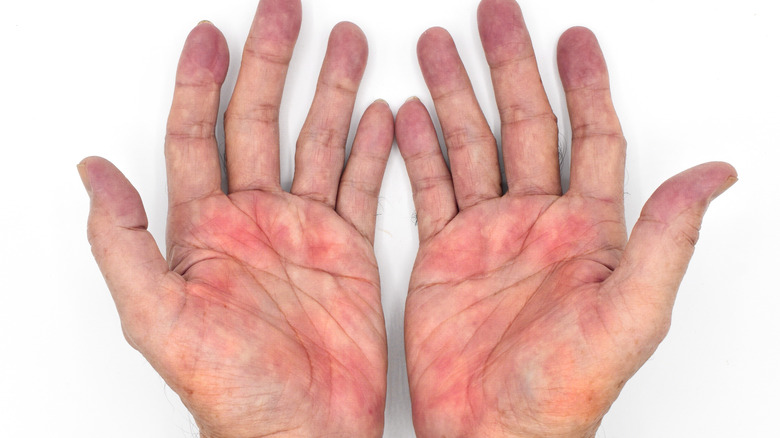Symptoms Of Cirrhosis Explained
In the Warner Bros. cartoon "Knighty Knight Bugs," one of the knights of the round table is named Sir Osis of Liver. It's a clever joke, but in reality, cirrhosis is no laughing matter. And despite the fact that Sir Osis is the only knight at the table who drinks anything in the cartoon, you can still develop cirrhosis even if you never consume alcohol.
According to the Mayo Clinic, cirrhosis involves the scarring of the liver. Now, various conditions and situations can damage one's liver. These include not only consuming large amounts of alcohol, but also health issues like chronic viral hepatitis and nonalcoholic fatty liver disease. Regardless of what injures the liver, when it's damaged, it develops scar tissue. Eventually, this scarring can make it harder for the liver to perform its many functions, which is called decompensated cirrhosis. And yes, cirrhosis can progress to the point where a person's life is in danger.
So, can cirrhosis of the liver be reversed? Well, if it's caught early on, it's possible to at least prevent further damage and even undo existing damage, although the latter is rare. However, once a liver is damaged because of cirrhosis, it will typically remain damaged. And the bad news doesn't stop there. The majority of the time, cirrhosis that isn't extensive doesn't have symptoms. With that said, here are some of the signs of cirrhosis to watch out for and discuss with a medical professional.
Jaundice
Even though there are some common signs of cirrhosis, whether someone develops symptoms and which symptoms they develop can vary from person to person (via Cleveland Clinic). Case in point: A cirrhosis patient might develop jaundice.
If you've ever seen someone with jaundice, one of the first things that might have stood out is the whites of their eyes appearing yellow (per Cleveland Clinic). This is a common sign of jaundice, along with one's skin and mucus membranes turning yellow. The reason for this is due to high amounts of a pigment called bilirubin. Per MedlinePlus, bilirubin is in bile, which your liver creates. In fact, bilirubin comes from red blood cells when they break down. And unfortunately, if someone has jaundice as a result of cirrhosis, it's usually a sign that the liver is having problems functioning properly as opposed to an early sign of cirrhosis, according to the Cleveland Clinic.
Of course, there's more than one possible reason why someone develops jaundice, which can mean they might experience more than just the yellowing of their eyes and skin. For example, jaundice because of an infection can also involve flu-like symptoms. So, whether or not you suspect you have cirrhosis, if you have jaundice, see a medical professional immediately.
Slurred speech
According to the Cleveland Clinic, around half of patients with cirrhosis also experience symptoms related to a condition called hepatic encephalopathy, also referred to as portosystemic encephalopathy (PSE). But no matter what it's called, it's possible to develop slurred speech as a result of it.
The liver normally filters toxins that are produced when the body breaks down substances like alcohol and medications. But cirrhosis can interfere with this liver function, which means toxins can remain in one's blood, accumulate, and eventually reach the brain. As a result, a person can develop hepatic encephalopathy — specifically, the type C version of this neurological disorder. Slurred speech is one of a number of possible symptoms connected to this health problem.
While it can be frightening when one's speech becomes slurred, the majority of the time, hepatic encephalopathy is temporary. With that said, don't make the mistake of not taking it or cirrhosis seriously. The two can be connected, so it's important to properly treat cirrhosis. Otherwise, hepatic encephalopathy can worsen and, in some cases, even result in a hepatic coma.
Confusion and personality changes
Imagine this: You have an uncle who has cirrhosis and begins acting very differently. While he's always been very polite, he suddenly starts saying inappropriate things. He's also forgetful and becomes confused — two things that rarely happen to him. While there can be a number of reasons for these changes, it also could be connected to cirrhosis and another related medical condition (via WebMD).
When a person develops cirrhosis, their liver can have a harder time filtering toxins from their system. As a result, the toxins can build up, circulate to the brain, and cause hepatic encephalopathy, which can affect someone both physically and mentally. And like other health conditions, hepatic encephalopathy can vary in how it affects someone, both in terms of which symptoms it causes and how slowly or quickly those symptoms manifest themselves. But confusion and personality changes — as well as crankiness, nervousness, excitedness, and loss of interest — can be signs of hepatic encephalopathy.
Even if someone is experiencing mental and emotional changes because of hepatic encephalopathy, it's possible they might not realize it. This is where family and friends are crucial to letting them know that they're not quite acting like themselves.
Weight loss and loss of appetite
There are a number of health conditions that can cause weight loss and/or loss of appetite. With that said, both of these health issues could be because of your liver.
According to StatPearls, when a person has cirrhosis, they can experience both loss of appetite and weight loss. Because of this, a doctor might recommend changing your diet in part to take some pressure off your liver while still taking in foods to help with your nutritional needs (via Healthline). For instance, since your liver makes bile, and bile helps the body break down the fats in food, you might want to avoid eating fried foods. Processed meats might also be off the menu if you're changing your diet because of cirrhosis. These include foods like bacon, hot dogs, and deli meats. Undercooked foods can also be problematic for a cirrhosis patient, since cirrhosis can impact one's immune system.
Although you might have to give up certain foods if you have cirrhosis, there's still a variety of things you can eat. Fruits like peaches and oranges, as well as vegetables like cauliflower and broccoli, are all possible choices. Sources of protein like meat and eggs are definitely on the table, too. However, you should always check with a medical professional before changing your meal plan.
Fatigue
While cirrhosis doesn't always have symptoms, when they do occur, it can be a red flag of significant liver damage (via Mayo Clinic). Recognizing these red flags, however, can be tricky. For instance, fatigue, which can be a sign of a number of health concerns, is also a symptom of cirrhosis, as well as other related liver concerns.
To really understand cirrhosis, it's important to talk about fatty liver disease. As Johns Hopkins explains, there are two basic types of fatty liver disease: nonalcoholic fatty liver disease (NAFLD) and nonalcoholic steatohepatitis (NASH). NASH occurs when fat accumulates in the liver, causing inflammation and damage. Eventually, it can lead to cirrhosis. Symptoms of NASH tend to develop over time, and can include weakness and extreme tiredness. Additionally, when NASH becomes cirrhosis, a person can also experience other health problems, like internal bleeding and muscle wasting.
Although there currently isn't any medication that can get rid of the fat in one's liver, that doesn't mean a NASH patient can't do something to improve their situation and reduce the chances of developing cirrhosis. For example, a person with NASH might need to at least reduce their alcohol consumption. They also might need to reduce their over-the-counter (OTC) medication intake. But ignoring symptoms like weakness and fatigue can mean ignoring NASH and cirrhosis, and may lead to additional liver damage.
Swelling in the legs, ankles, and feet
As the Cleveland Clinic explains, when a person develops cirrhosis, they might experience swelling in areas of their body like their legs, their ankles, and their feet. However, a medical professional might refer to this as edema as opposed to just swelling.
Specifically, edema occurs when larger amounts of fluid than normal become trapped inside your tissues (per Mayo Clinic). Besides swelling, this can cause the skin to become stretched out and even shiny. You may also find that if you press down on a swollen area, it'll remain dimpled for a few seconds. And if not addressed, edema can cause other issues, like itchiness and pain. Also, the swollen area can be more susceptible to infections.
Although edema can be a symptom of cirrhosis, it also can occur because of something as simple as sitting in one position for too long, or if the person is pregnant (via Cleveland Clinic). Edema can also happen in relation to congestive heart failure, kidney disease, and kidney failure.
Abdominal swelling
Swelling in different areas of the body is a potential symptom of cirrhosis. This can include in areas like the legs, as well as in the abdominal area — a condition known as ascites (via Mayo Clinic). This occurs because a higher-than-normal amount of fluid amasses in the abdominal cavity. But if you're thinking this sounds more inconvenient than concerning, think again. Not only is this a red flag of liver damage, but there's also more than just swelling that can come along with it.
According to Johns Hopkins, depending on how severe ascites is, a patient can experience pain and issues moving without having discomfort. Besides feeling bloated and heavy, someone with ascites can also have indigestion, nausea, and vomiting. Additionally, that fluid can increase the chances of infections in the abdomen and hemorrhoids. That excess fluid doesn't necessarily stay put, either: It can get into someone's chest and cause breathing issues.
While weight gain can be a sign of ascites, a medical professional will need to do more than weigh a patient in order to diagnose ascites. Common tests used to determine if someone has ascites include taking a fluid sample from someone's abdomen via a needle, an MRI, or a CT scan. But if they conclude the patient has ascites, cirrhosis might be a concern, since it's the number one cause of this health problem.
Changes in urine
Even though we're told to discuss all symptoms with our doctors, talking about changes in one's bathroom routine can be embarrassing. After all, the details about our waste products are usually considered TMI. However, changes when it comes to one's urine can be a sign of cirrhosis and a serious related condition.
When your liver has cirrhosis and so isn't functioning properly, you can also develop hepatorenal syndrome (via MedlinePlus). This involves progressive kidney failure. Not surprisingly, symptoms of this condition can include urinating less (or in the case of kidney failure, not urinating at all). Also, someone with hepatorenal syndrome and liver failure (which can occur with cirrhosis) might have dark-colored urine. Make no mistake: Hepatorenal syndrome can be fatal. Per data, approximately 10% of all people hospitalized for liver failure will develop hepatorenal syndrome.
While you should see a medical professional if you notice changes in your urine, keep in mind that physical exams can only provide so much information. For example, a doctor might not be able to tell if one is experiencing kidney failure based solely on urine color, but other signs like jaundice and confusion could point to problems with one's liver, like cirrhosis. And once liver health issues are discovered, so too can other health problems.
Bruising and bleeding
At times, what might seem like a minor bump or injury can result in a bruise. But here's the thing: If you're finding that you're bruising more easily than usual, that can be a sign of cirrhosis (via Mount Sinai). And the reason might be tied to your digestive tract.
According to Mount Sinai, the bruising and bleeding that sometimes happens with cirrhosis can be because veins located in the digestive tract have become swollen. Specifically, these veins are located in the esophagus, and when they become larger than usual, they are referred to as varices (per Mount Sinai). Esophageal varices can happen to someone with cirrhosis, because when a liver becomes scarred, it's harder for blood to flow through it. This throws off the proper circulation of one's blood, possibly sending more to the veins in the esophagus. Once this occurs, these enlarged veins can break and bleed. Also, enlarged veins don't only occur in the esophagus; this swelling can also happen to the veins in the upper part of one's stomach.
Besides bruising more easily, a person with cirrhosis and bleeding esophageal varices might experience abnormal bleeding. Furthermore, there might be other signs of these ruptured enlarged veins, like changes in one's stool (ranging from black streaks to bloody stool), lightheadedness, and paleness.
Nausea and vomiting
There are many reasons why someone might have stomach problems. They could be nervous and feeling queasy because they're going to make a speech. Or they might have eaten something that didn't agree with them, causing them to vomit. Health issues can also be the culprit — which brings us to cirrhosis.
As the University of California San Francisco explains, a person with cirrhosis can experience nausea. What's more, the National Health Service for Scotland (NHS) points out that vomiting can also be a symptom of cirrhosis. It's also possible to vomit blood if you've been diagnosed with cirrhosis. This condition is called hematemesis, and according to the Cleveland Clinic, it can occur when cirrhosis leads to the veins in the esophagus becoming larger and weaker. Naturally, this can lead to the veins breaking.
Although vomiting blood can be connected to cirrhosis, it can also be the result of other health issues like peptic ulcers, which occur in the stomach or the duodenum. Another explanation could be arteries bleeding, a possible result of inflammation in the stomach lining or the esophagus. Also, chronic pancreatitis could be the reason why someone is vomiting blood. The bottom line is if you experience this possible symptom of cirrhosis, get medical help as soon as possible.
Changes to blood vessels
Cirrhosis and changes to one's skin can go hand in hand. For instance, cirrhosis can affect the capillaries in one's hands, causing the palms to become red (via Medical News Today). But that's not the only way that blood vessels impacted by cirrhosis can change one's appearance.
According to Healthline, a person with cirrhosis can develop dilated blood vessels near the skin's surface. As a result, the blood vessels can create a web-like appearance on the skin that's usually red, blue, or purple. Unsurprisingly, this condition goes by names like spider nevus, vascular spider, and spider angioma. Where they occur can vary, but they typically appear on the legs, neck, and face. They can cause a burning or aching sensation, and pressing on them can make them temporarily disappear because it obstructs the blood flow to those vessels.
Although spider nevi can be observed in patients who have cirrhosis that wasn't caused by alcohol consumption, they're more likely to occur in someone with alcohol-related cirrhosis. They can also happen because of other health concerns like hormonal changes and exposure to the sun.
Itchiness
Feeling itchy can be annoying, especially when there doesn't seem to be a reason for it (and thus, no apparent way to get rid of it). But as the Mayo Clinic points out, having itchy skin is a potential (albeit somewhat confusing) sign of cirrhosis.
The technical term for itchiness that can occur because of chronic liver disease is pruritus (via Healthline). A person experiencing pruritus might feel either itchy all over their body or in a specific area. Primary biliary cholangitis (formerly called primary biliary cirrhosis, per Healthline) occurs when the liver's bile ducts become damaged. It can not only cause itchiness, but also lead to cirrhosis over time.
Besides having a medical professional check the source of your itching, Healthline advises against scratching an itch. Scratching can lead to the skin becoming damaged, which could result in infections. You might want to try a few simple prevention tricks like cutting your fingernails short and wearing gloves or long-sleeved shirts.
Sensitivity to medication
Medication can be an important treatment for a variety of health issues. As the American College of Gastroenterology notes, the liver is instrumental in helping the body process oral medications. Unsurprisingly, cirrhosis can cause issues when it comes to such treatments.
As the University of California San Francisco points out, when a liver is scarred, it doesn't filter medicines from one's bloodstream as quickly as an unscarred liver would. As a result, medication can build up in one's body, which can make the person more sensitive to it. This is why a cirrhosis patient could also become more sensitive to a medicine's side effects.
While prescription medications can be a concern for someone with cirrhosis, so too can over-the-counter (OTC) medicines. In fact, the American College of Gastroenterology states that acetaminophen (Tylenol) can cause liver damage when taken in large amounts over several days or taken in a high dose once. Take note that if a pain medicine advertises that it doesn't contain aspirin, there's a good chance it contains acetaminophen.
Redness in palms
The expression "caught red-handed" usually refers to someone being found doing something wrong. However, for a cirrhosis patient, red-handed can take on a new meaning (although the redness typically doesn't affect the whole hand).
As Medical News Today explains, a person with cirrhosis might experience secondary palmar erythema, where the palms of their hands turn red. In fact, palmar erythema is very often referred to as liver palms. In particular, this redness occurs in the heels of the hands. However, the rest of the palms can also become red, and can even look like they're covered with a rash. This is because tiny blood vessels in the hands are drawing a larger amount of blood than normal to the surface, creating the redness. (If you press down on the palms, the redness will temporarily go away.)
While cirrhosis can be the cause behind palmar erythema, liver health concerns (like hemochromatosis and Wilson disease) or pregnancy may also be the culprit. Alternatively, the redness can occur on its own, a condition known as primary palmar erythema. Regardless, it's important to consult a doctor and determine why you're experiencing palmar erythema. If a health issue like cirrhosis is the reason, addressing it might help reverse some of the redness, at least.

